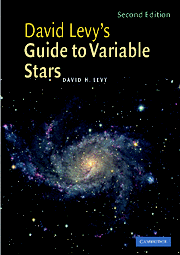Book contents
- Frontmatter
- Contents
- Foreword to the first edition
- Preface
- Acknowledgments
- Part I Getting to know the sky
- Part II Getting to know the variables
- 5 Meeting the family
- 6 Getting started with Cepheids
- 7 Algol, the demon of autumn
- 8 How to estimate a variable
- 9 Names and records
- 10 How your observations help us understand a variable star
- 11 Observing hints
- 12 Observing with CCDs
- 13 Stately and wonderful
- 14 Stars of challenge
- 15 Bright, easy, and interesting
- 16 Betelgeuse: easy and hard
- 17 Not too regular
- 18 Nova? What nova?
- 19 Supernovae
- 20 Clyde Tombaugh's star and the family of cataclysmic variables
- 21 A nova in reverse?
- 22 RU Lupi?
- 23 Orion, the star factory
- 24 Other variable things
- 25 The Sun
- Part III Suggested variables for observation throughout the year
- Part IV A miscellany
- Index
20 - Clyde Tombaugh's star and the family of cataclysmic variables
from Part II - Getting to know the variables
Published online by Cambridge University Press: 05 August 2012
- Frontmatter
- Contents
- Foreword to the first edition
- Preface
- Acknowledgments
- Part I Getting to know the sky
- Part II Getting to know the variables
- 5 Meeting the family
- 6 Getting started with Cepheids
- 7 Algol, the demon of autumn
- 8 How to estimate a variable
- 9 Names and records
- 10 How your observations help us understand a variable star
- 11 Observing hints
- 12 Observing with CCDs
- 13 Stately and wonderful
- 14 Stars of challenge
- 15 Bright, easy, and interesting
- 16 Betelgeuse: easy and hard
- 17 Not too regular
- 18 Nova? What nova?
- 19 Supernovae
- 20 Clyde Tombaugh's star and the family of cataclysmic variables
- 21 A nova in reverse?
- 22 RU Lupi?
- 23 Orion, the star factory
- 24 Other variable things
- 25 The Sun
- Part III Suggested variables for observation throughout the year
- Part IV A miscellany
- Index
Summary
The discovery of TV Corvi
On April 11, 1963, a group of visitors stood in the small gallery facing the largest telescope at Kitt Peak National Observatory at the time, the 84-inch reflector. After the tour guide explained the operation of the great telescope, he asked if there were any questions. One 14-year-old certainly had one. “How does an astronomer get permission to use this telescope?” he asked. “This telescope at the National Observatory,” the guide hissed, “is available only to qualified personnel.”
I was that 14-year-old. Two years later, on December 17, 1965, I began my project to search the sky. On that night, my goal was to begin a search of the sky that might yield a comet, or possibly a nova. A quarter century later, I found a nova, but it did not involve my use of a telescope.
On February 9, 1986 – coincidentally the perihelion date of Halley's Comet – I was in the basement archives at Lowell Observatory poring through hundreds of paper envelopes that Clyde Tombaugh used to store his photographic plates. It was a part of a biography I was writing about the man who had discovered Pluto. These plate envelopes had been replaced with modern archival envelopes, but the originals, complete with Clyde's detailed notes of observation, were still stored in a filing cabinet.
- Type
- Chapter
- Information
- David Levy's Guide to Variable Stars , pp. 112 - 125Publisher: Cambridge University PressPrint publication year: 2005



